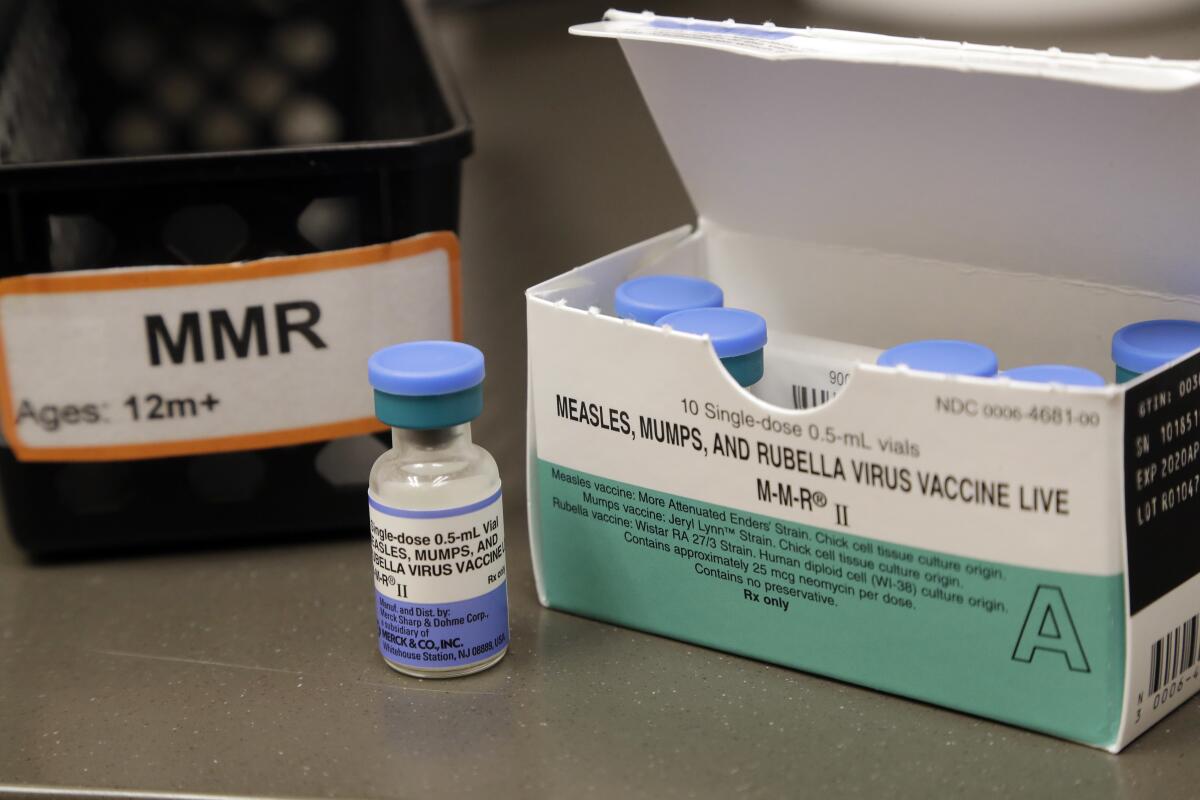Apodaca: Ongoing misinformation about MMR vaccinations flies in the face of facts, imperils children

- Share via
Throughout a career spanning three decades, Dr. Jasjit Singh has seen people die. Of course she has. An expert in pediatric infectious diseases, she currently serves as assistant director for the division for Children’s Hospital of Orange County and the medical epidemiologist for CHOC Hospital.
In her line of work, disease and death come with the territory.
But it’s particularly tragic when those deaths are entirely avoidable. And worse still, when they involve children— unvaccinated children who succumb to diseases that we know how to prevent.
“I have seen kids die of flu, pertussis, meningococcus,” she said. “It is so devastating.”
But here we are, in 2025, confronting once again diseases that we had long ago conquered. Or so we thought. The factor that might have been overlooked in our success with vaccines — one of the greatest triumphs in medical history — is that people are often irrational.
How else to explain declining vaccination rates and growing skepticism over the safety and efficacy of standard childhood vaccines that have been proven, over and over again, to be overwhelmingly safe and effective?
We see the consequences of such thinking currently playing out in parts of Texas and New Mexico that are experiencing a measles outbreak in communities with low vaccination rates. One child and one adult have died, while more than 350 people have contracted the disease so far. By the time this column appears, there will likely be more people infected.
California has some of the toughest school vaccination laws in the nation, and a relatively high level of compliance. But don’t for a second think that an outbreak couldn’t happen here, as it did in late 2014 and early 2015 when at least 131 measles cases were identified, most connected to Disneyland.
Sure enough, some measles cases have recently been reported throughout the state, including one of an Orange County infant who arrived at Los Angeles International Airport last month following overseas travel. More are likely on the way.
It’s no mystery why measles is resurgent in some areas.
New data from the California Department of Public Health show that 93.7% of kindergarten students were vaccinated against measles, mumps, and rubella in the 2023-2024 school year. That’s down from 94.1% the previous year — continuing a years-long decline — and below the 95% threshold for achieving herd immunity, the level at which we are considered protected from these viruses taking hold and spreading.
That’s worrisome enough, but there’s another important point to consider.
Statewide, or even countywide, vaccination rates mask the fact that rates vary substantially community by community, school to school, and there are many under-vaccinated pockets at risk of becoming the nexus of an outbreak.
So while the overall immunization rate for kindergartners in Orange County remains well above that 95% threshold — undeniably good news — the levels at some schools and among many home-schooled children don’t meet that mark. Parents can, and should, request information on vaccination rates from their children’s schools.
Let’s be clear about one other common misperception, which is the belief held by some that measles isn’t a dangerous disease or at least not as risky as the MMR vaccine itself. We have decades of data and reams of research debunking such assertions. And it’s an utter myth, yet a frustratingly persistent one, that the vaccine can cause autism.
It’s impossible to ignore that the misinformation about vaccines is occurring against a backdrop of greater skepticism about science and public health generally, and a political environment that feeds distrust of expertise and doubts about established facts.
While no medical intervention is entirely without risk, those posed by standard vaccines are vanishingly small compared to those of the terrible diseases they help prevent. The negative health effects of measles, in particular, are often underestimated; it is by any measure a serious disease.
The measles virus is extremely contagious, and it typically causes a high fever, rash, sore throat, fatigue, sensitivity to light, severe headaches and other symptoms that can last for two weeks or more. Also, as Singh notes, measles wipes out a part of the immunological memory, making those who have had the virus more susceptible to other diseases such as pneumonia and encephalitis for an extended period of time.
It’s possible that, in a strange way, vaccines have become a victim of their own success, in that many people might not now fully appreciate, because they’re haven’t seen for themselves, the dangers of diseases that we had once believed were under control. Nor does everyone apparently understand the awful price we will pay if immunization rates continue to fall.
Sadly, they might soon learn.
“What I guess I’m worried about in the meantime [is] how much pain and suffering will occur, particularly in children,” Singh said.
Can this troubling trend be turned around? For highly skilled professionals like Singh, there is no choice but to try. Vaccines might be the biggest public health accomplishment in modern times, but that success will only continue if people receive the correct information — and believe it. On that score, much work remains to be done.




